Most of the commonly used window coverings are good for maintaining privacy and controlling the levels of light entering a room but do nothing for keeping warmth in during winter and heat out during summer. This includes:
- Venetian blinds
- Roller blinds
- Vertical blinds
- Plantation shutters
Window insulation requirements
There are two key requirements to preventing heat loss/gain through a window covering:
1. The material/covering/curtain/blind itself needs to be an insulator – it needs to restrict heat transfer through it. This is the same principle that applies to wall or roof insulation.
2. It needs to prevent heat loss due to air movement around the window covering caused by convection. Any curtain or blind that has gaps around the edges will result in the air between the window and the curtain cooling and escaping out the bottom setting up a convection current.
At a minimum 3 sides of the curtain should be close fitted with minimal gaps for air flow. Failing to do this will negate most of the benefits of the curtain.
You can detect and assess the drafts around existing curtains by carefully holding incense sticks around the edges. The direction of the flow of smoke will identify any drafts that exist.
Insulated Curtains
An insulated curtain should be made up of 3 layers.
1. Face fabric
2. Liner – usually called bumph
3. Rubber-backed curtain lining
I’m not aware of pre-made insulated curtains available so they will need to be custom made. Lined curtains are not common in most parts of Australia so curtain makers may require some encouragement to meet your request.
A bumph lining can often be retro fitted to curtains that already consist of a face and backing fabric. Bumph is available from Lincraft or Just Linings.
Insulated thermal curtains are significantly heavier than traditional curtains and consideration may need to be given to the curtain tracks used. Most curtain tracks provide a rating in kilograms per meter, check this against the combined weight of your fabric. Forest Drapery Hardware and Silent Gliss both manufacture rails suitable for heavy curtains.
Pelmets
Pelmets are an important component in allowing the curtain to be effective. They’re always custom made so we’ll examine how they work in a little more detail to help you understand the design considerations.
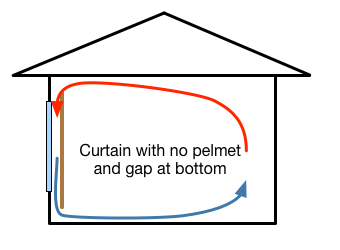 Looking side on at a curtain in a warm house with cold air outside. The air in the gap between the curtain and the window cools with contact with the cold window, sinks (being heavier) and thus sucking warm air in from the top of the room. This sets up a convection circuit within the room and process continues.
Looking side on at a curtain in a warm house with cold air outside. The air in the gap between the curtain and the window cools with contact with the cold window, sinks (being heavier) and thus sucking warm air in from the top of the room. This sets up a convection circuit within the room and process continues.
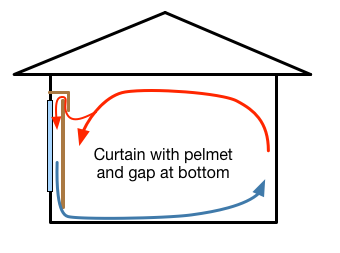 Installing a pelmet over the top of the curtain helps forcing the air to take a diverted path around the pelmet rather than being able to move across the room and sink down. Note that if a gap remains at the bottom of the curtain however air which is cooled from contact with the window will still drop down creating the suction needed to pull air around the pelmet. The pelmet on its own will restrict but not prevent the convection circuit.
Installing a pelmet over the top of the curtain helps forcing the air to take a diverted path around the pelmet rather than being able to move across the room and sink down. Note that if a gap remains at the bottom of the curtain however air which is cooled from contact with the window will still drop down creating the suction needed to pull air around the pelmet. The pelmet on its own will restrict but not prevent the convection circuit.
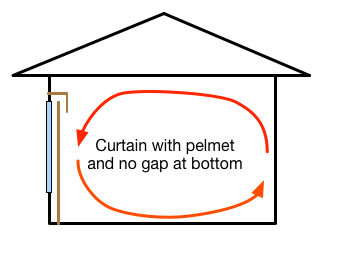 Once the curtain is extended all the way to the floor the circuit is completely broken, preventing a flow of air and significantly increasing the insulation benefit provided from the curtain.
Once the curtain is extended all the way to the floor the circuit is completely broken, preventing a flow of air and significantly increasing the insulation benefit provided from the curtain.
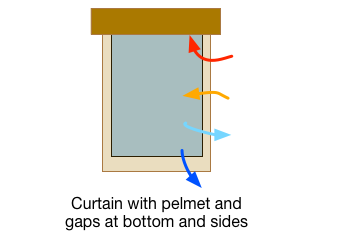 Looking face on at a window with curtain and pelmet installed you can see that if gaps remain at the sides, cool air is still able to escape from the lower edges causing warm air to be sucked in around the top. Preventing this requires a curtain installation that either
Looking face on at a window with curtain and pelmet installed you can see that if gaps remain at the sides, cool air is still able to escape from the lower edges causing warm air to be sucked in around the top. Preventing this requires a curtain installation that either
a) wraps around the ends of the curtain track such that the curtain makes contact with the wall or
b) is installed within the window reveal / sill.
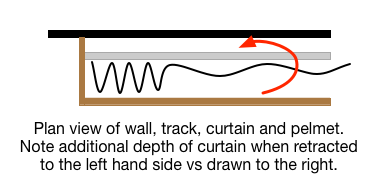 In designing your pelmet, consideration needs to be given to the dimensions, how tall, how far it protrudes from the wall and the size of the gap that exists between the top of the rail/curtain and the top of the pelmet. Remembering the goal of the pelmet is to restrict the flow of air around the top of the curtain and down into the cavity between the closed curtain and the window.
In designing your pelmet, consideration needs to be given to the dimensions, how tall, how far it protrudes from the wall and the size of the gap that exists between the top of the rail/curtain and the top of the pelmet. Remembering the goal of the pelmet is to restrict the flow of air around the top of the curtain and down into the cavity between the closed curtain and the window.
As illustrated in the diagram, the depth of the pelmet is constrained by the space need for the curtain when it is pulled back or opened. The curtain bunches up and needs more depth. Without enough space you won’t be able to open the curtain.
This means that when the curtain is closed there will always be a gap for air to move through, you can’t prevent this.
Some curtain track configurations may allow you to fill the gap between the wall and the curtain track.
Set the depth of the pelmet no deeper than is needed to accommodate the opened curtain.
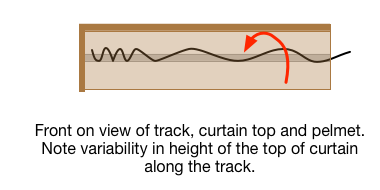 The next diagram depicts the pelmet looking face on, the black line represents the top of the curtain. As shown the top edge will vary up and down in height a little, you can place the curtain close to but not touching the pelmet. There’s more opportunity to close the air gap here than between the face of the curtain and the pelmet shown above.
The next diagram depicts the pelmet looking face on, the black line represents the top of the curtain. As shown the top edge will vary up and down in height a little, you can place the curtain close to but not touching the pelmet. There’s more opportunity to close the air gap here than between the face of the curtain and the pelmet shown above.
Some curtain tracks can be directly fixed onto the top of the pelmet rather than the wall. The exact gap is then controlled by placement of the hooks in the curtain.
I’ve not been able to find any minimum height based on testing but consensus seems be that 200 – 300mm is an ideal height for a pelmet. This assumes that the top of the curtain is as close to the top of the pelmet as possible (ie < 20mm). The taller the pelmet or the more the vertical overlap with the curtain the more that the airflow will be restricted.
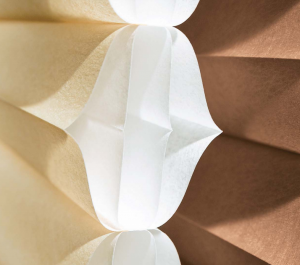 Honeycomb Blinds
Honeycomb Blinds
A number of vendors offer honeycomb blinds which trap air within cells and acting like a double glazed window.
Suppliers:
- Luxaflex Duette shades
- Vista Cellular Blinds
- Various others: Google “honeycomb blinds” or “cellular blinds”
To be effective insulators these blinds must be mounted within the window reveal, doing so means that there is minimal gap (circa 1cm) for air movement around all sides.
Alternatives to curtains and blinds
Some houses and windows simply don’t lend themselves to the use of curtains, alternatives that you may wish to consider include:
- Curtains are most useful for retaining warmth in cold periods. To keep the heat out external shading of windows is more effective.
- Double glazed windows and thermally efficient window frames (timber, uPVC or aluminium with a thermal break).
- Retrofitted films and secondary glazing such as Renshade, Enerlogic or Clear Comfort.
- A very different approach but installing an oversized solar PV system combined with battery storage to power an air-conditioner may become a very real and equally sustainable option in the near future. For new builds good design and double glazing are small incremental costs but for renovations they mean sending working windows to landfill, with significant labour and associated costs.

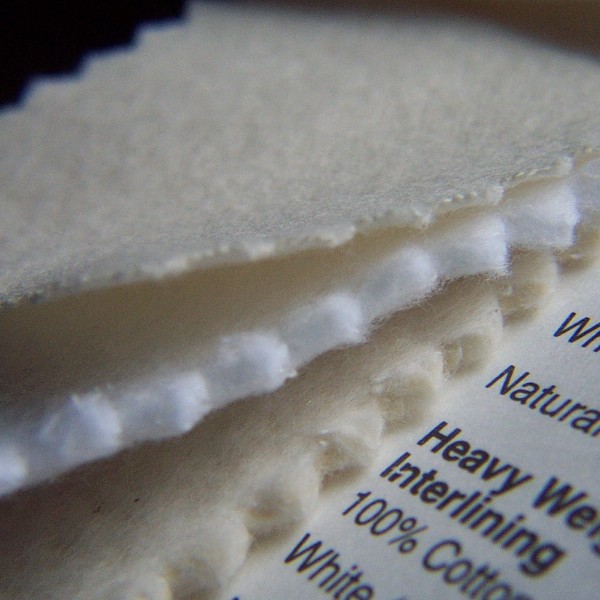
 Honeycomb Blinds
Honeycomb Blinds